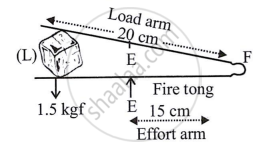Advertisements
Advertisements
प्रश्न
A fire tongs has arms 20 cm long. It is used to lift a coal of weight 1.5 kgf by applying an effort at a distance 15 cm from the fulcrum. Find:
- the mechanical advantage of fire tongs and
- the effort needed.
उत्तर
M.A. =?
Effort arm = 15 cm
Load arm = 20 cm

M.A. = `"Effort arm"/"load arm"`
M.A. = `15/20`
M.A. = `3/4`
M.A. = 0.75
Effort = ?
Effort = `"Load"/"M.A." = 1.5/0.75` = 2.0 kgf
APPEARS IN
संबंधित प्रश्न
Explain the term mechanical advantage.
Define the term velocity ratio.
When does a machine act as (a) a force multiplier, (b) a speed multiplier? Can a machine act as a force multiplier and a speed multiplier simultaneously?
- State the relationship between mechanical advantage, velocity ratio and efficiency.
- Name the term that will not change for a machine of a given design.
How is the mechanical advantage related with the velocity ratio for an actual machine? State whether the efficiency of such a machine is equal to 1, less than 1 or more than 1.
Draw diagrams to illustrate the position of fulcrum load and effort, in the following:
A seesaw
Draw a diagram to illustrate the position of fulcrum load and effort, in the following:
Forceps
A machine works as a
- force multiplier,
- speed multiplier.
In each case, state whether the velocity ratio is more than or less than 1.
In class II lever, effort arm is ______ than the load arm.
Mechanical advantage = ______ × velocity ratio.
